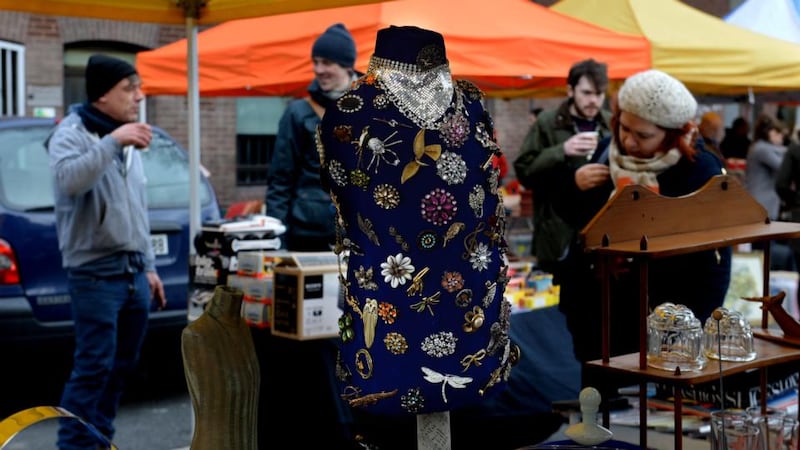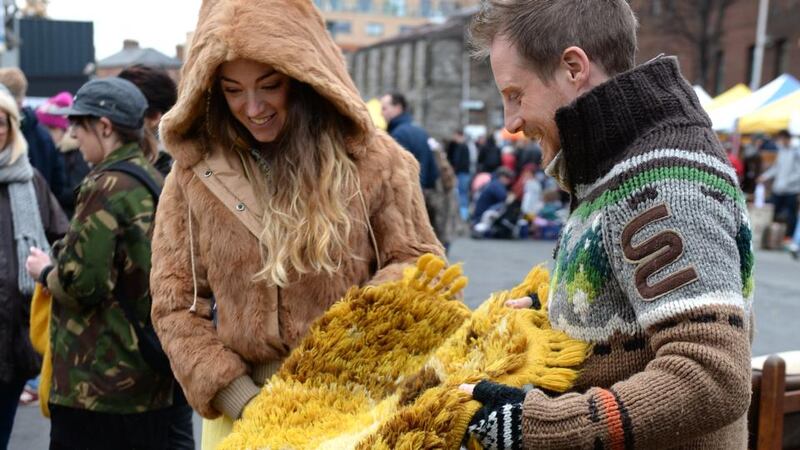Within the 115 sq km of Dublin city, there is really only one spot where you can be fairly certain of finding stiletto-shaped wine holders, second World War newspapers, Fisher Price toys from the 1970s and leather bibles – the Dublin Flea Market, held on the last Sunday of the month in Newmarket Square, Dublin 8.
As you approach the Coombe, a sign warns “Flea Market – diversion ahead”, and indeed, diversion is exactly what it is. It can entrap you for hours, even if you’ve no interest in retro furniture, vintage clothes or chipped china.
It’s a spooky temporal intersection point in the Venn diagram of circles of people you’ve long lost touch with. There are the predictable sideburn-and-quiff types who re-emerged having been cryogenically frozen upon the demise of the Dandelion Market 40 years ago, and the young Dublin 8 arty crowd who appear in every play and band from Whelan’s through the Project Arts Centre to the Abbey.
0 of 4
A Ukrainian man who furnished his whole apartment at last month’s Flea is back for some extra chairs and cutlery. Prop buyer and designer Sarah Kingston is trawling for treasures for a movie and keeping an eye out for things her private clients might like. She found a 3ft metal shark at a previous Flea which four people tried to buy from her later that same day.
Louis Lovett is browsing on his one day off from a national tour of The Girl Who Forgot to Sing Badly. Antony Farrell of Lilliput Press is trying on a German hunting jacket with antler buttons, while a bunch of teenagers are desperately seeking their identity in a chest of clothes containing an ageing widow's sequined pants and a dress labelled The Sexy Rose of Tralee.
Sharon Greene of the creative collective, Queens of Neon, founded the Dublin Flea Market in November 2008 with Luca D’Alfonso and Aisling Rogerson (who went on to create Fumbally Café) as a non-profit social enterprise to offer a platform to informal traders. It was a direct corollary of the economic crash.
“All my life I’ve been addicted to flea markets,” says Greene, “ and when Mother Redcaps and the Blackberry Market closed, I used to have to go to Berlin. As it happened, 2008 was the perfect time to set up a market. People were sickened by the boom and bling. They wanted value, and to be more creative, to turn away from labels towards a more personal, eclectic aesthetic.”

There are now more than 60 stalls and fierce competition to be allocated one of the spots. The few regular stall holders arrive at 8am to stake out their territory and set everything up for the 11am start. These gritty hoarders and rooters are the determined subset of humanity who’ve always rummaged in the detritus of society, picking out and polishing up our discarded gems and selling them back to us. They are the colonisers of abandoned settlements and will be the first to establish dominion when we finally find the remnants of life elsewhere in the universe. Wrapped in heavy post-apocalyptic outdoor gear, they unload crates, cases and trolleys of our unwanted possessions onto trestle tables.
More interesting are the nervous first-timers. Girls emptying their closets of unwanted dresses and shoes to pay for tuition fees, or boys about to emigrate to Australia selling off the remnants of their childhood.
Each stall has a story. Elaine Lavery recently managed to attract Dragon's Den funding for her Improper Butter range of butters flavoured with things such as Cashel Blue cheese and chilli and basil. She's here selling off children's rolling pins and cookie cutters that she used as side business in college.
The actor Mary-Lou McCarthy makes €220 with two friends, selling clothes they had forgotten at the back of their wardrobe. Their real profit comes from matchboxes on which they have glued the covers of classic novels and are selling for €2 each.

Greg Brown of Moon Shipping Co in Belfast is testing his range of Scandinavian homewares to see if it's worth opening a Dublin shop, and a girl who wishes not to be named is selling off her purple 'Docs', pink Converse and a Basquiat DVD before moving to Southampton.
Sharon Greene delights in the variety. “People use the market as a springboard into business; testing a new product or gaining confidence before opening a place of their own. On the flipside, when shops close they get to sell off their old stock, and then, when people are forced to emigrate, at least they have a chance to make a bit of money on their old gear.” A whole community has now grown up around the Flea. It’s one of the few social outlets on a Sunday that doesn’t involve alcohol, but how long it can continue is uncertain.
Newmarket Square fell into a Rip Van Winkle sleep in the 1950s, after centuries as a bustling hub of weavers, tanners and brewers. Developers moved in around the millennium, spreading their colonising nests of apartments. Now, finally, the high-end shops and businesses are beginning to sniff around and soon leases will likely skyrocket. At last month’s Flea, Colin Harmon, the grand duke of high-end single-estate coffees, was eyeing up sites for a potential new 3FE coffee roastery, while picking through boxes of clunky 1970s cups and saucers.
If you are in the market for dubious artworks and old John Rocha gear, or the very best falafels in Dublin, you know where you need to be on the last Sunday of every month. See dublinflea.ie. The market takes place on the last Sunday of every month, 11am to 5pm














